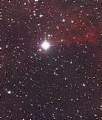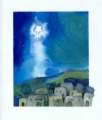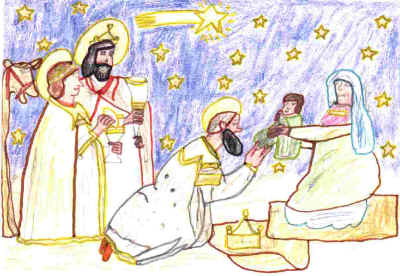
(Matthew 16:13-23)
May these words of this Peter be like a rock,
not a stumbling block!
|
|
"Who do you say
that I am?" Jesus asked. Simon Peter answered, "You
are the Messiah, the Son of the living God." And Jesus
answered, "Blessed are you, Simon son of Jonah! ... You are
Peter (petros), and on this rock (petra)
I will build my church..." Jesus then began to speak of
the rough road ahead. And Peter took him aside and rebuked him... "Get
behind me, Satan!" Jesus replied. "You are a stumbling
block..." (Matthew 16:13-23) May these words of this Peter be like a rock, |
"Perceiving the Star"
Message preached January 6,
2002
Long Green Valley Church of the Brethren
Glen Arm, Maryland USA
based upon
Matthew 2:1-12
 "Seeing
is believing," the man said as he stared at the report card. "Doesnít
look to me like thereís been any improvement, young man."
"Seeing
is believing," the man said as he stared at the report card. "Doesnít
look to me like thereís been any improvement, young man."
"Iíll try harder this term, Dad," his son replied with head hung low.
"Iíll believe it when I see it."
++++++++++
 "Seeing
is believing," the woman said as she stared at her home. "You said if
I went back to work, youíd do your share of the housework."
"Seeing
is believing," the woman said as she stared at her home. "You said if
I went back to work, youíd do your share of the housework."
"I have done more, dear," he replied from the easy chair in the middle of a cluttered room, with remote in hand.
"Show me."
++++++++++
 "Seeing
is believing," the teenage daughter said as she stared at her parents.
"What difference does it make whether we go to church or not. Taraís
family doesnít go anywhere and theyíre just as good as we are. I donít see
why I should have to go."
"Seeing
is believing," the teenage daughter said as she stared at her parents.
"What difference does it make whether we go to church or not. Taraís
family doesnít go anywhere and theyíre just as good as we are. I donít see
why I should have to go."
Her parents didnít know what to say.
++++++++++
"Seeing is believing," the old adage goes. And the words are full of wisdom. Sometimes we have to see something tangible in order to believe that what we do makes a difference, or that what others say is more than "just words." ... "Seeing is believing." A valuable code by which to live. Except, itís not always true. "Seeing is believing" ainít necessarily so.
We can see something but not believe it. Or more so - we can look at something and not really see it. For instance, we can look at a letter on a report card, and take it for more than it is, an indicator. A grade indicates a direction in which a child is progressing. It is not a measure of that young personís value or worth. For one child it means one thing, for another it means something different. It depends upon how you look at it.
Consider, also, a house after a wife begins working outside the home - or even before the fact. "Donít you see it?" is a common complaint from one side of an argument to the other concerning cleanliness, or the lack thereof. Seeing a place in need of housework does not necessarily mean believing that it does.
Further, we can look at the church and see something unappealing. Itís boring to those whose sense of time is determined by their age. The wide open horizon awaits exploration, after all. Why waste these moments on stuff that seems uninteresting and slow... On the other hand, to those who measure time by the much briefer span of years that lie ahead, the church is changing too much. The years behind prove a much better gauge of what is real.... Then again, to those who see only what they wish to see, the church is full of hypocrites. Indeed, we all fall short...
Yes, I guess thatís it. "Seeing is believing" is true. Though we so often see only what we want to see. However, even this is not quite the case, for we can want to see something and still not see it, and therefore not believe it.
Like a person I know whose life at one time was in a bit of a shambles. She realized she needed help. So she picked up her Bible and determined to start "in the beginning" and read to the end. Needless to say, she didnít get very far, and soon the Bible sat in her drawer as many "Gideons" do. She saw the words - she really wanted to - and yet she didnít see the Word. Seeing is not necessarily believing. Interestingly enough, at that time this woman was a resident of Missouri, the "Show Me" state.
++++++++++
"We
three kings of Orient are ... following yonder star..." Beyond the fact
that scripture makes no mention of there  being
only three of them, or that they were "kings," nevertheless, these
Magi (or "wise men") had seen something and were drawn to it.
being
only three of them, or that they were "kings," nevertheless, these
Magi (or "wise men") had seen something and were drawn to it.
A star in the sky... Much speculation has been made over the centuries as to what this star was. A comet, perhaps Halleyís comet... an alignment of planets...Itís interesting to speculate, though Iím not convinced - nor, when it comes right down to it, do I care whether the star can be rationally explained. If it were proved beyond a shadow of doubt that this star, like the "shroud of Turin," was for real, would people today really see it and believe it? After all, seeing is believing.
I very seriously have my doubts. Why? Because few were those who saw the star when it did shine long ago. Few really saw ... and believed. That, in a sense, is the point of this story of the wise men. The star shone. It pointed like a promise to the place where the "star" of the universe lay, the Christ-child. And yet, who really saw the star? A bunch of magicians from the east. Unbelievable!
It wasnít
until this wandering band of star-gazers journeyed through Jerusalem that anyone
else took any notice. Then they saw the star, but they didnít really see it.
Oh, they had the scriptures, and these were searched. Sure enough, there it was  -
a prophetic promise pointing to an obscure little town called Bethlehem. Most
folks were unaware that this sleepy borough was the home of another star of
Israel - a guy named David. Now he was a king!
-
a prophetic promise pointing to an obscure little town called Bethlehem. Most
folks were unaware that this sleepy borough was the home of another star of
Israel - a guy named David. Now he was a king!
So was Herod, only Herod was one who saw only what he wanted to see. What Herod saw was a threat rather than a promise. "A ruler to govern Israel will come from Bethlehem," the promise read. Herod believed enough to quake in his boots a bit, and determined to nip the potential competition in the bud. Later he would order the murder of every infant in Bethlehem, but not before the star-child would be secreted away. God is not so easily thwarted.
The star shone. Many saw it, of course. City lights were not as bright then, nor pollution as bad. No doubt it was visible. Itís a bit like the Bible today. We say with pride how it still is a best-seller. Itís highly visible. But is it really seen? Is it really read? Is it really believed?
The star shone. Herod was made aware of it. He saw what he wanted to see, and acted as he wished. But did he really see it. There are many today who act the same, liberals and conservatives alike.
 The star shone. Those Magi saw it. Of course, there is some question as to
whether they knew what it was they saw. Nevertheless, they were drawn to
Bethlehem by the star. They perceived its significance. They came. They
worshiped what they saw. They gave gifts ... and they left, having received a
warning to keep away from Herod.
The star shone. Those Magi saw it. Of course, there is some question as to
whether they knew what it was they saw. Nevertheless, they were drawn to
Bethlehem by the star. They perceived its significance. They came. They
worshiped what they saw. They gave gifts ... and they left, having received a
warning to keep away from Herod.
++++++++++
Martin Luther, the great 16th century reformer of the church, used this account of the three wise men to make a statement about the Bible, about how there is more to the Word of God than just the words on paper. This Word needs to be spoken aloud, lifted up, revealed. Listen to what Luther said:
(The star of Bethlehem, the star of the wise men, should be in every case) "the lively preaching and simple revelation of Christ as he is hid and promised in Scripture. Therefore (the one who really) sees the star knows assuredly the King of the Jews, the newborn Christ; for the Gospel teaches nothing but Christ, and Scripture likewise has nothing but Christ. But whoever does not know Christ may hear the Gospel or hold the book right in his hands, but understanding of it he does not have yet, for to have the Gospel without understanding is to have no Gospel. And to have Scripture without the knowledge of Christ is to have no Scripture, and is none other than to let this star shine and yet not perceive it."
(As quoted in Church Dogmatics 1:1, p. 123, by Karl Barth, ©1975, T & T Clark.)
Letting the star shine and not perceiving it... We do that a lot, donít we? May I venture to say that the star shines here among us. Now, as always, there are those who claim that it doesnít, that the light is very dim and may soon be extinguished. But I donít believe that is the case. The star shines - at times its brilliance can be blinding. I think the problem is that we donít often perceive it. However, just because we donít perceive it doesnít mean it isnít there.
++++++++++
In the calendar of the Christian year, January 6th is the day of Epiphany. Epiphany is the celebration of the coming of the Magi to the Christ-child. It is the celebration of the first appearance of Jesus Christ to those who were not descendants of Abraham, Isaac and Jacob - that is, Gentiles. The time between this day and Ash Wednesday (Feb. 13), the first day of Lent, is known as the season of Epiphany.
 Epiphany is not exactly a word we use on a daily basis. Literally,
"Epiphany" means "to show oneself," "to appear,"
"to make visible." ... Epiphany ... The Magi perceived the star when
no one else did. They followed the star - a long journey. Then, finally, the
object of their search was revealed, made visible to them In that tiny child -
born in near poverty, vulnerable - they saw something worthy of worship.
However, if God had not revealed himself to them, I doubt they would have
perceived this birth to be anything other than ordinary.
Epiphany is not exactly a word we use on a daily basis. Literally,
"Epiphany" means "to show oneself," "to appear,"
"to make visible." ... Epiphany ... The Magi perceived the star when
no one else did. They followed the star - a long journey. Then, finally, the
object of their search was revealed, made visible to them In that tiny child -
born in near poverty, vulnerable - they saw something worthy of worship.
However, if God had not revealed himself to them, I doubt they would have
perceived this birth to be anything other than ordinary.
Epiphany ... God reveals himself to us in such a way that we are able to perceive his presence. The star shines for us, and we are empowered to see it... Epiphany.
++++++++++
"Seeing is believing," the old adage goes, though we know full well that we see only what we want to see, and even then we often are blind. Epiphany ... In a strange way this season of the Christian year emphasizes for us that, in reality, "believing is seeing." Without belief, the star shines and we perceive it not. By faith, we perceive the star and are guided by its light along the way of our common Christian journey.
I think itís
appropriate that Epiphany is celebrated at this time of year. The new year
provides us with an occasion to  reflect
upon the past year - something our brother Mark encouraged us to do last Sunday.
Perhaps as we reflect upon 2001 we should ask one question: In what ways did God
appear to us this past year? With the gift of hindsight, then, where do we
perceive this star (whether or not we actually "see it") continuing to
shine today?
reflect
upon the past year - something our brother Mark encouraged us to do last Sunday.
Perhaps as we reflect upon 2001 we should ask one question: In what ways did God
appear to us this past year? With the gift of hindsight, then, where do we
perceive this star (whether or not we actually "see it") continuing to
shine today?
Where is the star, the light of Christ, shining before you/me today? Are you really seeing it shine? Are you willing to follow where it leads?
(1/3/88 ... 1/6/91)
©2002 Peter L. Haynes